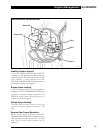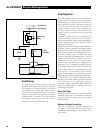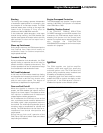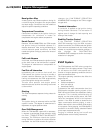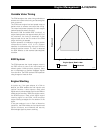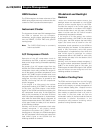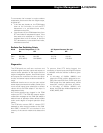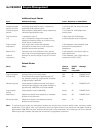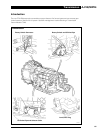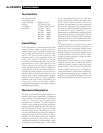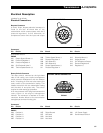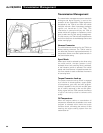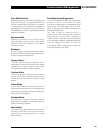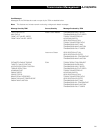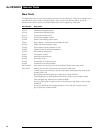
AJ-V8/5HP24
69
Transmission Management
Gear Shift Interlock
Gear shift interlock is controlled by the BPM, part
of the SCP network. The gearshift release will
only be activated when the ignition is in position
II, transmission is in Park and the brake pedal is
depressed. Once transmission is out of Park, the
brake pedal has no effect on gearshifting and the
interlock is disabled.
Reverse Inhibit
Selection of reverse with the vehicle moving
forwards above walking pace is electrically
inhibited, unless the vehicle is in the default
"limp-home" mode.
Kickdown
A floor mounted switch/pedal position sensor
signals the TCM to select the lowest gear to give
maximum torque for acceleration.
Torque Control
The TCM synchronises the operation of the
transmission clutches and invokes shift energy
management to control engine output torque
during a gear shift (Refer to EMS, page 60).
Traction Mode
The traction program compliments the traction
control system and is implemented whenever
traction control intervenes to maximize wheel
stability.
Cruise Mode
Cruise mode reduces unwanted hunting of the
transmission gearshifting and is activated when
cruise control is resumed and when the vehicle is
cruising near the set speed.
Gradient Mode
The gradient program enhances vehicle
performance, driveability and cooling when the
vehicle is climbing a gradient.
Start Inhibit
The rotary switch also provides the start inhibit
function to the ECM, which will not allow an
engine start until the gear selector is in either
Park or Neutral.
Fault Monitoring/Diagnostics
The TCM constantly monitors the transmission
system for faults. In the event of a fault
occurring, the transmission is protected by a limp
home mode. This mode allows use of P, R, N,
and 4. It also signals the ECM to switch on the
CHECK ENG (MIL) lamp.
The TCM is able to diagnose faults in
components which affect exhaust emissions.
Communication with the PDU is through the
J1962 connector which allows accurate diagnosis
of transmission problems. Additional diagnostic
functions facilitate fast repair of faults. All
transmission OBDII information is stored for
future data analysis in the ECM.



